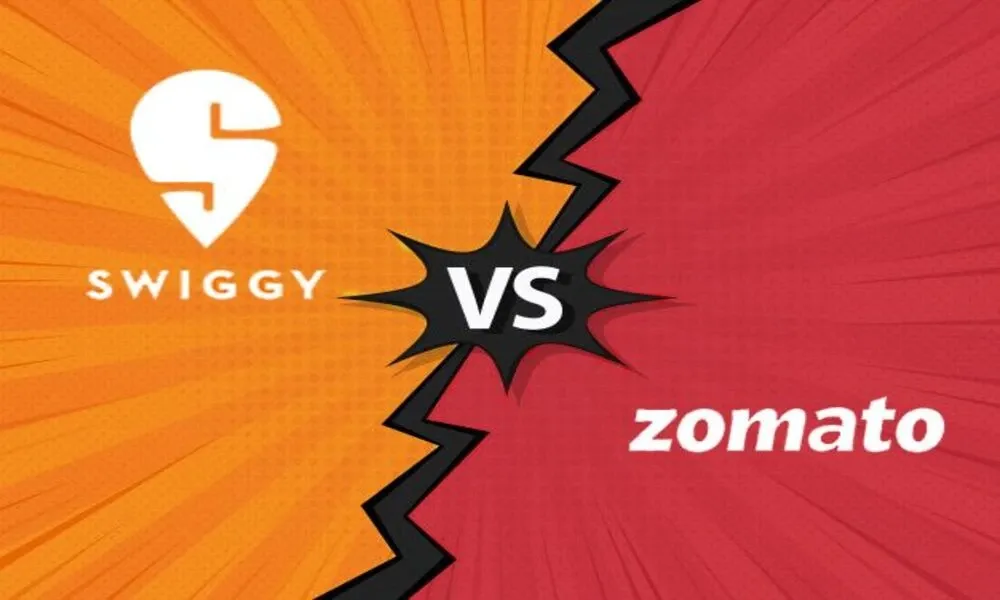Market News
Swiggy IPO: How it stacks up against rival Zomato in food delivery and quick commerce
.png)
4 min read | Updated on November 03, 2024, 11:12 IST
SUMMARY
Zomato leads Swiggy in key metrics, including GOV, AOV, and profitability. While Swiggy has improved revenue and reduced expenses, Zomato’s stronger market position, positive contribution margin, and larger user base give it a competitive edge.

Upcoming Swiggy IPO: How It stacks up against rival Zomato in food delivery and quick commerce
Swiggy provides its users with an easy-to-use platform that they can access via a single app to search, select, order, and pay for food (Food Delivery), grocery and household goods (Instamart) and have orders delivered to their homes via an on-demand delivery partner network.
Industry Overview
The Indian food services market, which includes both online food delivery and out-of-home consumption, was valued at ₹5,60,000 crore (US$70 billion) as of 2023. The online food delivery segment alone will show an impressive projected compound annual growth rate (CAGR) of 17–22% until 2028. Additionally, the online dining segment is expected to grow significantly, with a 46–53% increase anticipated from 2023 to 2024.
India’s retail market stood at approximately ₹7,60,000 to ₹7,80,000 crore in 2023, with grocery sales making up 61% of this share. This sector has seen substantial disruption due to the rise of quick commerce platforms like Blinkit(Zomato), Swiggy Instamart, Zepto, etc.
The industry recorded between 0.8–0.85 crore Annual Transacting Users (ATUs) in 2023, with a considerable 25–29% of these users being Monthly Transacting Users (MTUs). This proportion is projected to increase to 27–32% by 2028. The Average Order Value (AOV)—defined as the average value of a single order, pre-discount and including taxes and customer delivery charges but excluding tips—has also risen from around ₹290–320 (US$3.6–4.0) in 2018 to approximately ₹425 (US$5.3) in 2023.
Let's compare two major players: Swiggy v/s Zomato
Financials Metrics of Swiggy v/s Zomato
| Financial Metrics | Swiggy | Zomato |
|---|---|---|
| Revenue (in ₹ Cr) | 11,634 | 12,114 |
| Loss/Profit (in ₹ Cr) | −2,350 | 351 |
| Market Cap (in ₹ Cr) | 87,299 | 2,21,262 |
Swiggy's post-issue market capitalisation will be around 87,299 crore, valued at its upper end of its price band. Meanwhile, Zomato’s market capitalisation stands at ₹2,15,000 crore, which is approximately 2.5 times that of Swiggy.After several quarters as a loss-making company, Zomato has recently shifted into a positive financial trajectory, while Swiggy continues to face challenges.
In FY2024, Swiggy’s revenue grew by 34% in 2024, with its net profit margin improving to -20%, a significant recovery from -60% in 2022. This reflects Swiggy’s ongoing efforts to improve its financial performance.
The company has also cut down on expenses significantly, reducing its technology and cloud infrastructure costs to 2.54%, advertising and sales promotion expenses to 15.91%, and employee benefit expenses to 17.30% all nearly half of their 2022 levels.
Let's compare Swiggy and Zomato on the Quick Commerce segment: Q1FY25
Blinkit vs Swiggy Instamart
| Company | GOV (in ₹ Cr) | AOV (in ₹) | Average Monthly Transacting Users (in Cr) | Active Dark Stores | Contribution Margin (as a percentage of GOV) |
|---|---|---|---|---|---|
| Instamart | 2,724 | 487 | 0.52 | 557 | -3.18% |
| Blinkit | 4,923 | 625 | 0.76 | 639 | 4% |
Gross Order Value (GOV):
Zomato's Blinkit leads with a GOV of ₹4,923 crore, significantly higher than Swiggy’s Instamart ₹2,724 crore. This indicates a higher transaction volume or value per transaction for Zomato than Swiggy.
Average Order Value (AOV):
Zomato’s AOV is ₹625, whereas Swiggy’s is lower at ₹487. This suggests that Zomato’s customers tend to place higher-value orders on average.
Average Monthly Transacting Users:
Zomato also has a higher number of Average Monthly Transacting Users at 0.76 crore (7.6 million), compared to Swiggy’s 0.52 crore (5.2 million). Zomato’s larger user base could contribute to its higher GOV and AOV.
Active Dark Stores:
Zomato operates 639 active dark stores, slightly more than Swiggy’s 557. More dark stores could mean better logistical coverage and possibly faster delivery, giving Zomato an edge in customer experience.
Contribution Margin:
Zomato shows a positive contribution margin of 4%, indicating profitability at the unit level. Swiggy, on the other hand, has a negative contribution margin of -3.18%, suggesting it incurs a loss per transaction on average. Zomato’s positive margin suggests better cost efficiency.
Overall, Zomato outperforms Swiggy in all key metrics, including GOV, AOV, monthly transacting users, and contribution margin. This indicates stronger financial health and operational efficiency for Zomato relative to Swiggy.
Related News
About The Author
Next Story


